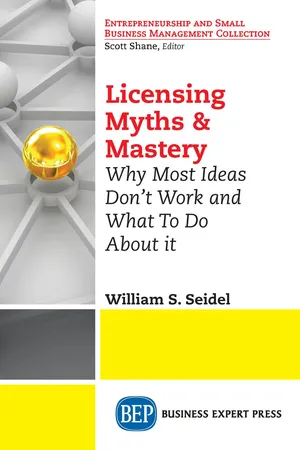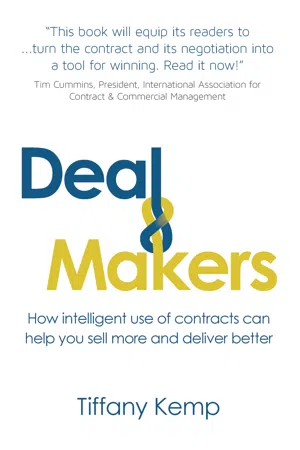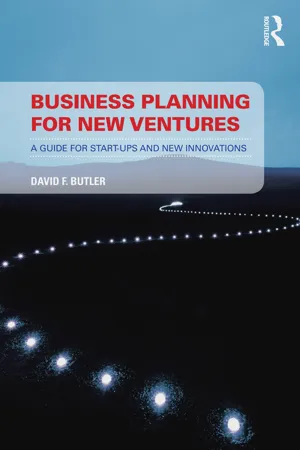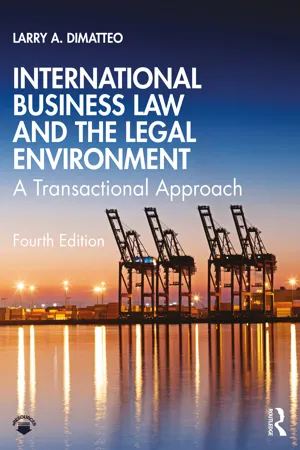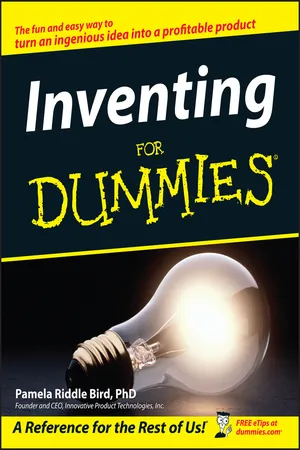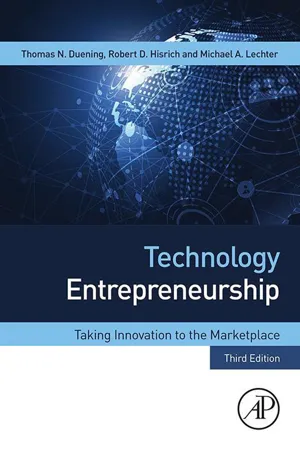Technology & Engineering
IP Licensing
IP licensing refers to the process of granting permission to use intellectual property, such as patents, trademarks, or copyrights, in exchange for a fee or royalty. This allows the owner of the IP to generate revenue from their creations while enabling others to legally use and benefit from the protected technology or content. Licensing agreements typically outline the terms and conditions of use.
Written by Perlego with AI-assistance
Related key terms
8 Key excerpts on "IP Licensing"
- eBook - ePub
- William S. Seidel(Author)
- 2017(Publication Date)
- Business Expert Press(Publisher)
CHAPTER 1Understanding Licensing
1.1 Introduction
If you have ideas, concepts, works of art, literary works, music, inventions, designs, processes, methods, or brands, you have Intellectual Property (IP). You can sell it; license usage rights; or fund, market, and distribute it yourself. It is even possible to license ideas to a few companies.IP is an intangible property created in someone’s mind. It has value just like real property and fits in two categories: Hard Rights include protected property like patents, trademarks, and copyrights, and Soft Rights include unprotected property like trade secrets, know-how, and concepts.The concept of licensing is relatively simple. The word, from Latin, means permission, given by one party who controls something to another party who desires it. Your IP has value, someone or some company may want to exploit it, and a license is the right to use it.Licensing works because of international laws for government-issued rights of patents, trademarks, and copyrights, protecting intellectual property. Without the legal ownership of names, works of art, inventions, and the ability to restrict exploitation by others, commercialization and innovation as we know it would not exist. This affects everything we see and use from movies and books to cars and smartphones.A license is a contractual grant, the License Agreement , by the owner, the Licensor , of the intellectual property rights to the party desiring to use part or all of those rights, the Licensee . A license agreement grants the licensee permission to commercialize the project by manufacturing, marketing, and/or distributing it while paying for those rights. As a licensor, you become a vendor to the company, under protection by the company, and you may even contract and work with the company. A license agreement is more like a profit-sharing agreement or an employment agreement than a sales agreement.Licensing creates one of the greatest financial freedoms anyone can attain. If all goes right, licensing has the ability to create Passive Income - eBook - ePub
Deal Makers
How intelligent use of contracts can help you sell more and deliver better
- Tiffany Kemp(Author)
- 2013(Publication Date)
- Anoma Press(Publisher)
To date, I’ve had a 100% success rate with these ‘cease and desist’ letters, with the infringers immediately taking down the infringing content in most cases, and within a few days for the others. One bemused recruiter explained that he had outsourced the development of his new website to an offshore web development company, and was not aware that he even had any terms and conditions on the site. The developers had obviously found our terms and adopted them lock, stock and barrel – including my client’s company registration details!If you own an IPR, you control the right of others to use it
When you own an intellectual property right, you can use it as you choose. When it comes to commercialising it, that might mean that you choose to exclude anyone else in the world (or a particular country) from using it, so that you benefit exclusively from its wonderfulness.Alternatively, you might realise that others have more resources to exploit and generate business from your IP than you do. Or you might want to work with others to help you exploit it yourself. What are the mechanisms for granting rights to others without giving your IPR away?The most obvious mechanism, used by software vendors the world over, is to grant a client a limited licence to use your IP. So in the case of software, this means granting your client a licence to use the copyrighted computer source code (probably) as compiled into some form of executable.(By the way – in English, we use ‘licence’ with a ‘c’ for the noun – “we grant you a licence to use...”and ‘license’ with an ‘s’ for the verb – “we license you to use...” In America, they use an ‘s’ for both flavours.)If you have a patented invention, you might want to license a manufacturer to use your patent for the purpose of manufacturing goods for supply to you. Or you could grant a reseller licence, enabling them to manufacture the goods and sell them directly to end users, paying you some form of royalty for each unit made and/or sold.These days, most commercial manufacturing seems to be done in China or other eastern countries. There are still significant concerns, however, about how safe your IPR is in the hands of a Chinese manufacturer – with some justification, given the prevalence of ‘knock off’ brand-name goods in Chinese markets. - eBook - ePub
Business Planning for New Ventures
A guide for start-ups and new innovations
- David Butler(Author)
- 2014(Publication Date)
- Routledge(Publisher)
12Managing intellectual propertyOutcomes and objectivesFor the majority of innovative or technology-based ventures, the protection of their Intellectual Property (IP) is a key aspect of achieving and maintaining a competitive advantage over their competitors, but that protection comes with a high financial cost. This chapter has been included to give an understanding of the main types of IP that relate to technology-based start-ups, and a range of issues around the protection and commercialisation of that IP, including:● The importance of protecting Intellectual Property.● The argument for first-to-market strategies as opposed to IP protection.● The main types of IP (patents, patent licences, copyright), and an outline of other forms of IP.● The patent application process as it applies to new technologies, and the costs of patenting and annual renewals.● IP management: the ongoing maintenance of IP protection and issues around the defence of IP against infringements.● Commercial exploitation of IP and patent licensing.● Issues around the valuation of Intellectual Property for licensing, and for company valuation for potential trade sale or stock-market flotation.What constitutes intellectual property?Intellectual Property (IP) is a generic term that covers a wide range of very different items that have been generated from thought, conceptual idea, artistic and creative abilities, and technical or scientific research. Some of these items are tangible, such as physical inventions, whilst others are intangible, such as concepts or designs. IP is defined as the property of someone’s mind or intellect, and it can exist in a number of very different forms including:● - K. Hodkinson(Author)
- 2002(Publication Date)
- Routledge(Publisher)
• Licensing may be done involuntarily or at least reluctantly. It may be that you would prefer to produce or keep the technology for yourself, but that it is the only way of persuading another company to license something to you—a cross licence situation. Cross licensing is often a halfway house between straight licensing activity and a collaborative joint venture and in fact that is how many joint ventures start off. Usually the parties are relatively equal in standing and contribute pretty equally. The cross licensing device enables them to spread risk and to concentrate on their own part of the project without exhausting staff resources, making best use of each other’s expertise in complementary technological fields. The cross licensing provides a cheap way of developing a broader-based expertise and between them the two firms strengthen their hand against other rivals.Of course the success of such licensing is heavily dependent on the trust and mutual honesty of the two parties. It is very easy to get one’s fingers burnt. Alternatively you may be forced into giving (or for that matter taking) a licence as a means of settling a potentially damaging infringement action. This may be essential where the challenge appears quite strong or you simply do not have the money to fight it with. The licence cuts your losses and those of the licensee. An enemy becomes an ally, in whose interests the validity of the patent may well now be.• Finally, you may be forced to license out by the law itself or by the threat of the law, whether directly under the compulsory licence provisions which exist in some of the intellectual property regimes or because of the complaints of rivals of abuse of dominant position in the market by the right holder. Or you have to cut the cost of maintaining the right in existence by declaring the right to be available for licences of right, i.e. anyone who applies will be given one on reasonable terms. This reduces the cost of renewal fees for patents and designs.Thus, in sum, licensing produces income without capital investment and with a reduction of risk. It expands artificially the markets in which one can trade and therefore hopefully increases the turnover over capital asset ratio of the company. But again licensing out is not all pluses. There are a number of countervailing factors to consider before deciding on this particular line of activity.- eBook - ePub
- Charles Cooper(Author)
- 2012(Publication Date)
- Routledge(Publisher)
per se (nobody can ‘own’ information as long as it is not totally secret). From the monopoly power derived from such ‘ownership’ the technology supplier is able to impose conditions, in addition to tie-in arrangements, which would have been impossible in a more competitive market for technology. (These conditions, including restrictions on size and structure of production, price fixing, export restrictions, etc., will be dealt in the next part.) Hence, again, the coexistence between patent licensing and technology contracts.Patent licences, which are so often considered vehicles of technology transfer, are in most cases nothing more than import permits (since most patents are non-exploited in developing countries) given under certain conditions.37 The state grants monopoly privileges to foreign patent holders and consequently national as well as foreign-owned firms need import permits, which they get in the form of patent licences from the foreign patent owners, so as to import the protected products. Once a government has decided to grant patents the ability to import products covered requires the permission of the patent holder who in turn gives it only under certain terms.To summarize: since most patent licences given are in effect import permits; since the majority of patents are unexploited in developing countries; and since patents are a block to technology transfer and foreign investment, patents are a means for limiting or restricting the flow of technology from the industrialized to developing nations. ‘… Recent disclosures have abundantly documented this retarding tendency of patent reinforced monopoly in introducing commercially feasible inventions: in synthetic rubber, magnesium, methy-methacrilate plastics and dentures, tungsten carbide, higher potency pour-point depressants, fluorescent lighting, longer-life flashlight batteries, the repeater match, to name a few cases at random’ [Kahn, 1948, pp. 249–50].Patents are not only an impediment to technology transfer. They can also hinder possibilities for domestic research activities in developing countries. ‘A single 17-year monopoly of a minor cog in that huge mechanism of interlocking processes and contributions which make up an advancing art can for 17 years seriously retard continued research’ [Kahn, 1940, p. 482 - eBook - ePub
International Business Law and the Legal Environment
A Transactional Approach
- Larry A. DiMatteo(Author)
- 2021(Publication Date)
- Routledge(Publisher)
The gray market is one of the major risks of licensing IPR for the production of goods in other countries. Some of these countries have lower costs of production, which leads to the temptation to export licensed goods to higher priced markets, including the markets of the licensor and other licensees. It is crucial that the license contract combat the exportation of goods through territorial restrictions, maximum quantities of production, and maximum sales to individual purchasers. However, under some laws, such as EU competition laws, these provisions may be invalid.The most important clause in a license is the grant clause, which states the IPR rights, trade secrets, and know-how that are being licensed. The license may be exclusive or nonexclusive and include other restrictions, such as field of use. The grant-back clause deals with the ownership and right to use any improvements made by the licensee.Any exporter (licensor) of IPR should make sure it follows all necessary formalities, such as the registration of licenses in pertinent countries, as well as inserting clear duration and territorial provisions in its license so that ones will not be implied later by a court.- Common licensing clauses include the reservation of rights, royalties, best efforts, quality control, confidentiality, most-favored-licensee, infringement, and termination clauses.
In the U.S., the applicable law for licensing contracts is the common law of contracts. Other countries like China have specific rules that relate to licensing and technology contracts. The EU has strict regulations invalidating some pro-licensor clauses that violate EU competition law. - eBook - ePub
- Pamela Riddle Bird(Author)
- 2011(Publication Date)
- For Dummies(Publisher)
Chapter 20
Licensing Your Product
In This Chapter
Looking at licensing and licenseesRenting your patent to one or several companiesFinding potential licenseesSubmitting your productFiguring out what kind of licenses to grantA fter putting in all the hard work of thinking up your invention and then doing the evaluations and testing, handing your baby over to someone else to produce, market, and sell while you rake in the royalties may sound like a good idea. And licensing is certainly a good option for a number of inventors. However, I must warn you that only a small number of inventors — about 6 percent — succeed in licensing their products.There’s no harm in trying, though, and licensing can be the best way to go if you can hitch your invention to the right licensee. This chapter tells you how to go about it.Contemplating Licensing
Licensing is a contractual arrangement in which an individual or company grants specific rights to certain intellectual property. They grant another individual or company these rights in return for royalties and/or another form of payment. Basically, licensing means renting your invention to someone else. A licensee is a company to whom you give permission to manufacture, market, and distribute your invention.What are your chances?
No type of invention is more likely than another to be a good licensing candidate. Potential licensees, like investors, are often more interested in the inventor than the invention. If you do your part by investigating the market — choosing potential licensees because they’re a good fit for your invention and otherwise doing your homework — you have a much better chance of licensing your invention than someone who is so convinced of their invention’s worthiness that they expect the world to beat a path to their door. By putting time, effort, and money into your invention, you can raise the 6 percent rate to approximately 50 percent. - eBook - ePub
Technology Entrepreneurship
Taking Innovation to the Marketplace
- Thomas N. Duening, Robert A. Hisrich, Michael A. Lechter(Authors)
- 2020(Publication Date)
- Academic Press(Publisher)
In connection with patents, a right to prevent unauthorized use of a claimed invention by others. An exclusive right, however, does not necessarily give the patentee the right to practice the invention and should be distinguished from a “monopolistic” or “sole” right where the right holder is the only entity that has the right to provide an article or to practice a process.Expression The manner in which something is described, as distinguished from the thing that is described.Intellectual propertyThe intangible asset that comprises or results from human intellect, creativity, innovation, know-how, and reputation and encompasses all rights to technology and rights to benefit from one’s reputation.Interference proceeding A USPTO administrative proceeding pertaining to patents filed before March 16, 2013 to determine which of rival claimants was the first to invent a commonly claimed invention.Invention New technological developments or discoveries produced or created through the exercise of independent creative thought, investigation, or experimentation.Joint workA work prepared by two or more authors (coauthors ) with the intention that the respective contributions be merged into inseparable or interdependent parts of a unitary work.Know-how Accumulated practical skill, expertise, data, and information relating to a business and/or its operations or performing any form of industrial procedure or process.License agreementAn agreement under which the owner/proprietor of IP rights (the licensor) permits another entity (the licensee) to utilize the IP rights in return for some consideration, typically the payment of royalties.
Index pages curate the most relevant extracts from our library of academic textbooks. They’ve been created using an in-house natural language model (NLM), each adding context and meaning to key research topics.
